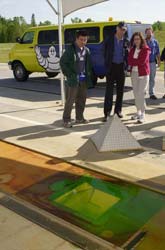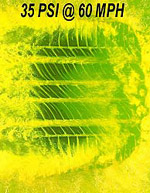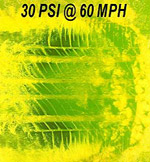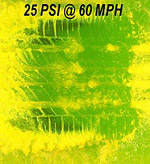| NEW RESEARCH REGARDING TIRE PRESSURE |
Tire Pressure Report...CanadianDriver was recently given access to some of the test vehicles and Michelin personnel at the Laurens proving grounds. One of the technologies used by Michelin is a camera embedded in the roadway to photograph the tire's contact patch (the part of the tire, about the size of your hand, in contact with the road at any one time) in various conditions. It was an excellent opportunity to experience and see the effects of tire pressure, tire placement and tire wear on everyday driving. |
||
It was also an exercise in how to prevent an accident happening to you. TIRE PRESSURE - Did you know that your tires lose one pound-per-square-inch (psi) per month, even if your wheels and tires are in excellent condition? Over time, air escapes, and your tires will slowly deflate. Is this really a big deal? Read on. Michelin prepared two cars to test on a water soaked circuit. Both Ford Crown Victorias of the same specification, the only difference was that one car's rear tires were five-psi below the manufacturer's recommended pressure. True, the Crown Victoria is not what you'd call a "handling" car (even though police forces love them), and driving this big, rear-drive vehicle through sharp turns on a wet surface is tricky enough at the best of times (ie: with tires at the correct pressure, in dry conditions). But the test car withproperly inflated tires was controllable, and did behave reasonably well. This was not the case for the other car. A mere five-psi difference in the rear tires was all it took to ruin that vehicle's ability to negotiate turns. The back end would quickly lose traction and the car would "fishtail" in classic rear-drive fashion. Some drivers had the car rotate 180- degrees before coming to a stop.Under-inflated tires, it turned out, not only wear more quickly, and cause you to use more fuel, but they can be decidedly unsafe. Check the Michelin-supplied pictures illustrating the contact patch of tires that are correctly inflated (in this case 35 psi, although that's not the correct inflation for all tires), underinflated by five psi, and underinflated by 10 psi. Notice how less of the tires' tread is in contact with the road as the pressure is reduced, hence the propensity to lose control at speed, especially on wet surfaces.This is so simple to fix by checking your tires monthly with a tire pressure gauge. But do make sure you know what the recommended pressure is (it's usually stamped in the door jamb and listed in your owner's manual - it's NOT on the tire), and do check them "cold," before the tires warm up from driving. Shortly, all new cars will feature standard tire monitoring systems, which should help consumers to maintain correct tire pressure. |
 Camera embedded in the road photographs tire's contact patch
at designated speeds.  Contact patch of tire running at manufacturers recommended pressure
 Contact patch of tire running
five-psi below manufacturer’s recommended pressure  Contact patch of tire running 10-psi below manufacturer’s recommended pressure |
|
Is Tire Placement Important?Ever replaced only two tires on your car? Where did you put them - front or back? Ever heard of hydroplaning? It's where the tire loses contact with the road, sliding on top of a water-covered surface. The questions above are related. The second car had new tires on the front, and tires that were 50% worn on the back. We started in the car with new tires on the back. Once up to speed (about 90 km/h) the front of the car started to lose traction. You could feel the front-end slide as the tires with 50% wear began to hydroplane. However, this was easily remedied, by taking your foot off the gas, letting the car slow down a little to regain traction, then getting back up to speed. None of our group lost control of the car with the new tires on the rear of the car. The second car had the new tires on the front, which is perhaps where you'd think to put them if yours is a front-drive car. Get more traction, right? Au contraire! Most of us couldn't |
|
get to 90 km/h because the back-end of the car would lose traction and violently slide around. Everyone went off the track, typically backwards. The rear wheels simply lost contact with the road because they didn't have enough tread. The front tires hung on, which caused the back of the car to pivot out of control. At Canadian- Driver, we recommend replacing your worn tires with a full set of four new |
|
Contact patch of new tire at 60 mp/h |
|
 |
|
Contact patch of 50% worn tire at 60 mp/h |
|
fones. But we recognize that isn't always possible. If you are replacing only two tires, this demonstration suggests that the new tires should be mounted on the rear, no matter whether your car is front-drive or rear-drive (assuming your car uses four tires of the same size). Check Michelin's video at www.michelinman.com/care/tip6.html to compare how cars react depending on whether the new tires are on the front or on the rear. Michelin's Laurens Proving Grounds tests a lot more than the effects of tire pressure and tire wear. Long distances at high speed, slow runs over deep potholes, bumps, gravel, and other extreme road surfaces are employed to confirm or test computer simulations. But even with Michelin's formidable research and development resources, the benefits of a modern tire can be undermined by running them under inflated, mismatched or incorrectly placed. |
|
